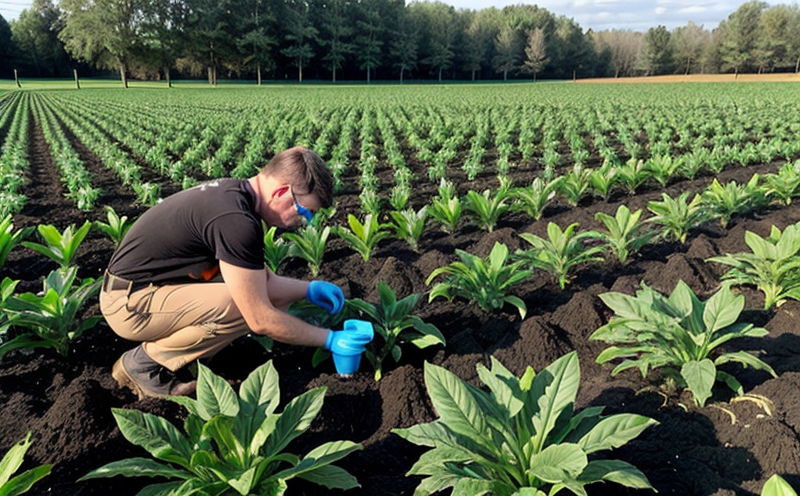Granule Size Distribution Testing in Fertilizers
Fertilizer granules play a crucial role in ensuring optimal nutrient delivery to plants. The granule size distribution directly impacts the dissolution rate of nutrients, which is key for plant health and soil fertility. Understanding this relationship enables precise control over how quickly fertilizers release their nutrients into the soil, thereby optimizing crop growth while minimizing environmental impact.
The testing of granule size distribution in fertilizers involves several critical steps to ensure product quality and performance. Samples are first taken from production batches or field samples, then carefully sieved through a series of standardized sieves with predefined aperture sizes. The weight retained on each sieve is recorded, providing data for analysis.
Once the sample has been prepared, it undergoes detailed analysis using particle size distribution instruments such as laser diffraction analyzers or sedimentation methods. These devices provide precise measurement and statistical evaluation of individual granule diameters within the batch. The resulting distribution curve helps identify whether there is an ideal balance between large and small particles that would enhance dissolution kinetics.
For instance, a fertilizer with too many fine particles might dissolve too rapidly, causing nutrient leaching before plants can fully absorb it; conversely, excessive coarse granules could result in slower release rates leading to inefficient use of resources. Therefore, achieving an appropriate range of particle sizes is essential for both efficacy and sustainability.
Industry standards like ISO 13567-2:2008 specify methods for determining the particle size distribution of solid materials by laser diffraction, including fertilizers. Compliance with these guidelines ensures accuracy and consistency across different batches produced by various manufacturers worldwide.
The importance of accurate granule size analysis extends beyond just manufacturing quality control; it also impacts downstream processes such as blending with other additives or mixing with soil amendments before application in fields. By ensuring uniformity within the desired range, farmers can achieve consistent results regardless of where they purchase their products from.
In summary, granule size distribution testing is not merely a formality but an integral part of producing high-quality fertilizers that meet both immediate agricultural needs and long-term environmental goals. Accurate characterization allows for better formulation decisions based on scientific evidence rather than empirical trial-and-error methods.
Why It Matters
The granule size distribution in fertilizers significantly influences several key factors affecting crop yield, soil health, and environmental sustainability. A well-balanced mix of particle sizes ensures efficient nutrient availability to plants while minimizing potential negative effects on ecosystems.
- Better Utilization: Properly sized particles enhance the dissolution rate of nutrients in soil, promoting faster uptake by crops without causing wastage through runoff or leaching.
- Eco-Friendly Practices: Reduced risk of over-fertilizing due to controlled release mechanisms supported by optimal granule distribution improves overall resource efficiency and reduces pollution risks associated with excessive nutrient application.
- Diverse Applications: Different crops have varying requirements for specific types of fertilizers tailored according to their growth stages. Precisely measured particle sizes allow formulators to cater more effectively to these needs, enhancing crop diversity.
Additionally, compliance with international standards helps establish credibility among consumers and regulatory bodies alike, fostering trust in the reliability of products offered by reputable suppliers like our laboratory.
Quality and Reliability Assurance
- Standardized Procedures: Adherence to established protocols ensures consistent results across multiple batches. Our team follows rigorous procedures outlined in ISO 13567-2:2008 ensuring precision in measurements.
- Accurate Instruments: Utilizing advanced laser diffraction analyzers guarantees accurate particle size distribution data, which forms the basis for reliable quality assessments.
Our commitment to maintaining high standards of accuracy and consistency extends beyond mere compliance with industry norms. We continuously invest in state-of-the-art equipment and training programs aimed at fostering expertise among our personnel.
In addition to technical excellence, we also emphasize traceability throughout the entire testing process. This includes keeping detailed records of all analytical activities performed on each sample submitted for analysis, ensuring transparency and accountability.
Environmental and Sustainability Contributions
- Sustainable Resource Management: By optimizing granule size distribution in fertilizers, we contribute to reduced waste generation during production processes. This aligns with broader sustainability objectives set forth by organizations like the United Nations Environment Programme (UNEP).
- Pollution Prevention: Minimizing nutrient loss through runoff helps protect water bodies from excess nitrates and phosphates, promoting healthier aquatic ecosystems.
Our services play a vital role in supporting global efforts towards sustainable agriculture practices. Through precise granule size distribution testing, we help ensure that agricultural inputs are used efficiently, thereby contributing to more resilient food systems capable of meeting future challenges posed by climate change and population growth.





